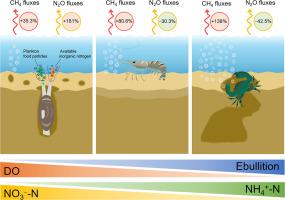Divergent impacts of animal bioturbation on methane and nitrous oxide emissions from mariculture ponds
IF 11.4
1区 环境科学与生态学
Q1 ENGINEERING, ENVIRONMENTAL
引用次数: 0
Abstract
Aquaculture systems are of increasing concern as an important source of atmospheric methane (CH4) and nitrous oxide (N2O). However, the role of animals in regulating CH4 and N2O emissions from aquaculture systems remains unclear. Here, we established mesocosm trials to investigate impacts of bioturbation of different aquaculture species (i.e., clam, shrimp, and crab) on CH4 and N2O fluxes in a mariculture pond. Across the initial, middle, and final culturing stages, mean CH4 flux in mesocosm without animals was 4.81 ± 0.09 µg CH4 m‒2 h‒1, while the existence of clam, shrimp, and crab significantly increased CH4 flux by 35.3%, 80.6%, and 138%, respectively. Bioturbation significantly decreased dissolved oxygen (DO) concentration by 5.19‒44.8% but increased porewater CH4 concentration by 14.1‒59.9%, indicating that lowered DO caused by animal respiration promoted CH4 production in sediment. Moreover, bioturbation of animals significantly increased ebullitive CH4 fluxes by 41.0‒216%, contributing 57.4‒77.2% of the increased CH4 emission in mesocosms with animals. However, shrimp and crab significantly reduced N2O flux by 30.3% and 42.5%, respectively, primarily due to lowered DO conditions suppressing nitrification and limiting NO3‒ supply for denitrification. By contrast, clam significantly increased N2O emission by 181% because its filter-feeding behavior excreted more NH4+ and NO3‒ into overlying water and thereby facilitating N2O production. The N2O concentration in overlying water was 1.72‒2.83-fold of that in porewater, and the calculated diffusive N2O flux was 1.80‒37.5% greater than chamber-measured N2O efflux. This implied that N2O might be primarily produced in overlying water rather than sediments, and the produced N2O can either evade as water-air fluxes or diffuse downwards into sediments to be consumed. Overall, our study advocates that aquaculture-related climate mitigation strategies should place more attention on the divergent impacts of animal bioturbation on CH4 and N2O emissions.

动物生物扰动对海产养殖池塘甲烷和氧化亚氮排放的不同影响
作为大气中甲烷(CH4)和氧化亚氮(N2O)的重要来源,水产养殖系统日益受到关注。然而,动物在调节水产养殖系统甲烷(CH4)和氧化亚氮(N2O)排放中的作用仍不清楚。在这里,我们建立了中观试验,研究不同水产养殖物种(即蛤、虾和蟹)的生物扰动对海产养殖池塘中 CH4 和 N2O 通量的影响。在养殖初期、中期和末期,无动物中层生物群落的平均 CH4 通量为 4.81 ± 0.09 µg CH4 m-2 h-1,而有蚌类、虾类和蟹类存在时,CH4 通量分别显著增加了 35.3%、80.6% 和 138%。生物扰动使溶解氧(DO)浓度明显降低了 5.19-44.8%,但孔隙水 CH4 浓度却增加了 14.1-59.9%,这表明动物呼吸导致的溶解氧降低促进了沉积物中 CH4 的产生。此外,动物的生物扰动显著增加了41.0-216%的逸散性CH4通量,占有动物的中观池中CH4排放量增加的57.4-77.2%。然而,虾和蟹分别显著降低了 30.3% 和 42.5% 的 N2O 通量,这主要是由于溶解氧降低抑制了硝化作用并限制了用于反硝化作用的 NO3-。相比之下,文蛤的 N2O 排放量明显增加了 181%,这是因为文蛤的滤食行为将更多的 NH4+ 和 NO3- 排泄到上覆水中,从而促进了 N2O 的产生。上覆水中的一氧化二氮浓度是孔隙水中的 1.72-2.83 倍,计算的一氧化二氮扩散通量比室中测量的一氧化二氮流出量高 1.80-37.5%。这意味着一氧化二氮可能主要在上覆水中而非沉积物中产生,产生的一氧化二氮可以通过水-空气通量或向下扩散到沉积物中被消耗掉。总之,我们的研究主张,与水产养殖相关的气候减缓战略应更加关注动物生物扰动对甲烷和一氧化二氮排放的不同影响。
本文章由计算机程序翻译,如有差异,请以英文原文为准。
求助全文
约1分钟内获得全文
求助全文
来源期刊

Water Research
环境科学-工程:环境
CiteScore
20.80
自引率
9.40%
发文量
1307
审稿时长
38 days
期刊介绍:
Water Research, along with its open access companion journal Water Research X, serves as a platform for publishing original research papers covering various aspects of the science and technology related to the anthropogenic water cycle, water quality, and its management worldwide. The audience targeted by the journal comprises biologists, chemical engineers, chemists, civil engineers, environmental engineers, limnologists, and microbiologists. The scope of the journal include:
•Treatment processes for water and wastewaters (municipal, agricultural, industrial, and on-site treatment), including resource recovery and residuals management;
•Urban hydrology including sewer systems, stormwater management, and green infrastructure;
•Drinking water treatment and distribution;
•Potable and non-potable water reuse;
•Sanitation, public health, and risk assessment;
•Anaerobic digestion, solid and hazardous waste management, including source characterization and the effects and control of leachates and gaseous emissions;
•Contaminants (chemical, microbial, anthropogenic particles such as nanoparticles or microplastics) and related water quality sensing, monitoring, fate, and assessment;
•Anthropogenic impacts on inland, tidal, coastal and urban waters, focusing on surface and ground waters, and point and non-point sources of pollution;
•Environmental restoration, linked to surface water, groundwater and groundwater remediation;
•Analysis of the interfaces between sediments and water, and between water and atmosphere, focusing specifically on anthropogenic impacts;
•Mathematical modelling, systems analysis, machine learning, and beneficial use of big data related to the anthropogenic water cycle;
•Socio-economic, policy, and regulations studies.
 求助内容:
求助内容: 应助结果提醒方式:
应助结果提醒方式:


